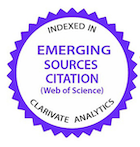AREA OF USE BY Hydrochoerus hydrochaeris L. IN AN URBAN ENVIRONMENT
DOI:
https://doi.org/10.1590/1809-6891v15i319663Keywords:
Animal BehaviorAbstract
The capybaras are quite common in the green areas of the capital of Paraná State, which include lakes and rivers within its boundaries. This study aimed to analyze the home range of a capybara population in one of these areas, the Tingui Park. The direct records of animal presence and some traces left by them in the studied area, as well as information regarding the social behavior of the species were recorded. The geographic coordinates of the recorded data were plotted on the Tingui Park map. The results showed that capybaras used the whole length of the park, however, there was a higher concentration of views, feces and marking territory in the northern region of the park, indicating that as the area of ??greatest use by capybaras. As for the behavior, the results showed instances of conflicts between the animals that may be related to competition for territory.
KEYWORDS: animal traces, green urban area, territoriality.
Downloads
Published
How to Cite
Issue
Section
License
Copyright (c) 2014 Brazilian Animal Science/ Ciência Animal Brasileira

This work is licensed under a Creative Commons Attribution 4.0 International License.
Authors who publish with this journal agree to the following terms:
- Authors retain copyright and grant the journal right of first publication with the work simultaneously licensed under a Creative Commons Attribution License that allows others to share the work with an acknowledgement of the work's authorship and initial publication in this journal.
- Authors are able to enter into separate, additional contractual arrangements for the non-exclusive distribution of the journal's published version of the work (e.g., post it to an institutional repository or publish it in a book), with an acknowledgement of its initial publication in this journal.
- Authors are permitted and encouraged to post their work online (e.g. in institutional repositories or on their website) prior to and during the submission process, as it can lead to productive exchanges, as well as earlier and greater citation of published work (See The Effect of Open Access).































